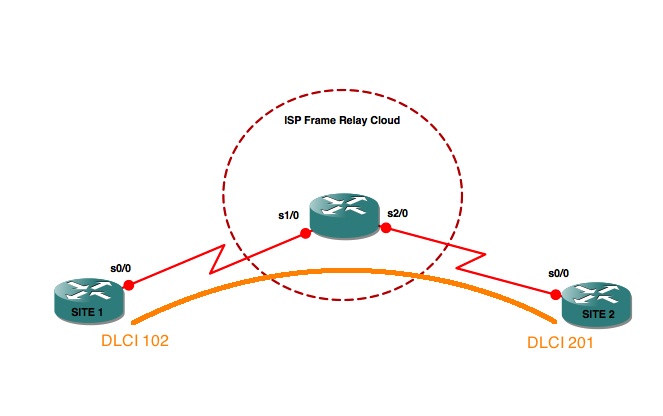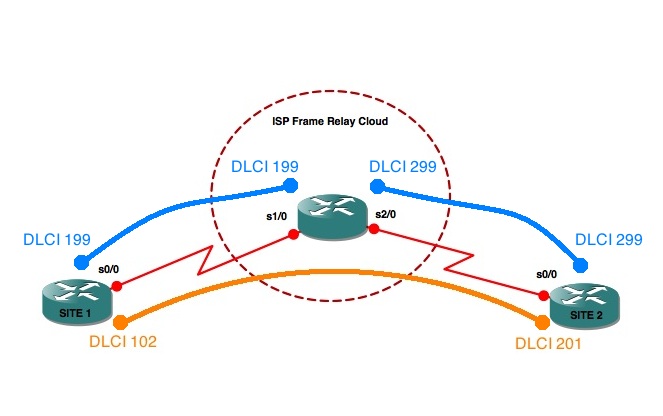I have recently been working on a few small frame relay networks, traditionally the networks will have two components, either a router that will “map” IP addresses to DLCI’s to traverse the frame relay intersite network. Plus the service provider core routers that will switch (route) the clients DLCI’s while performing any required changes to the frames.
This setup is much like an MPLS network where routers will either be configured as CPE (Customer Edge) and owned by the customer, PE (Provider Edge) or P (Provider/Core), typically it’s considered best practice to maintain this design and never have equipment multi-functioning. I will probably make a post on this shortly…
However I wanted to know could frame relay networks actually multifunction, more specifically could a router configured with the global configuration mode of a frame relay switch (shown below) actually terminate a frame relay connection and supply services over this connection.
Cloud(config)#frame-relay switching
So, why would you ever want to do this?
Well first look at the below image, there is a fairly simple setup of two client sites (1 and 2) plus a single provider frame relay cloud switch in the middle. Site 1 and 2 are connected via a DLCI connection simply put sending traffic out of 102 at site 1 will make it appear via 201 at site 2, and the opposite from site 2 to 1 is also true.
The starting point…
Now let’s consider that the client would like an internet service suppling over this existing serial frame relay connection, the existing service could be potentially re-developed however that’s a lot of hassle. In this case the single core router also has an internet IP table installed locally so the easiest way would just be to use this. In the below picture we add a new DLCI connection on both sites that terminates on the core router.
What we will end up with…
It’s a simple yet effective solution, and best of all it actually works your core frame relay switches are fully capable of performing this kind of end point termination for a frame relay network. Obviously I would rather keep them as separate functions, however for small networks, labs or even quick fixes it’s an interesting solution.
Configurations are below for your comfort, they are compacted to the required commands for easy viewing, please leave any thoughts in the comments below, thanks!
ISP Core Cisco Router
ISP(config)#frame-relay switching ISP(config)#interface Serial1/0 ISP(config-if)#encapsulation frame-relay ISP(config-if)#frame-relay route 102 interface Serial2/0 201 ISP(config-if)#frame-relay intf-type dce ISP(config-if)#clock rate 64000 ISP(config)#interface Serial2/0 ISP(config-if)#encapsulation frame-relay ISP(config-if)#frame-relay route 201 interface Serial1/0 102 ISP(config-if)#frame-relay intf-type dce ISP(config-if)#clock rate 64000 ISP(config-if)#interface serial1/0.199 point-to-point ISP(config-if)# ip address 10.2.2.2 255.255.255.252 ISP(config-if)# frame-relay interface-dlci 199 ISP(config-if)#interface serial2/0.299 point-to-point ISP(config-if)# ip address 10.2.2.6 255.255.255.252 ISP(config-if)# frame-relay interface-dlci 299
SITE1 Router Cisco 1760
SITE1(config)#interface Serial0/0 SITE1(config-if)#encapsulation frame-relay SITE1(config)#interface serial0/0.102 point-to-point SITE1(config-if)# ip address 10.0.0.1 255.255.255.252 SITE1(config-if)# frame-relay interface-dlci 102 SITE1(config-if)#interface serial0/0.199 point-to-point SITE1(config-if)# ip address 10.2.2.1 255.255.255.252 SITE1(config-if)# frame-relay interface-dlci 199
SITE2 Router Cisco 1760
SITE2(config)#interface Serial0/0 SITE2(config-if)#encapsulation frame-relay SITE2(config)#interface serial0/0.201 point-to-point SITE2(config-if)# ip address 10.0.0.2 255.255.255.252 SITE2(config-if)# frame-relay interface-dlci 201 SITE2(config-if)#interface serial0/0.299 point-to-point SITE2(config-if)# ip address 10.2.2.5 255.255.255.252 SITE2(config-if)# frame-relay interface-dlci 299





1 comments On Terminate DLCI endpoint on a Frame Relay switch
Forgot to mention, it would be easier using multipoint frame relay and having three endpoints, however the purpose of this exercise was to maintain a point to point frame relay infrastructure.